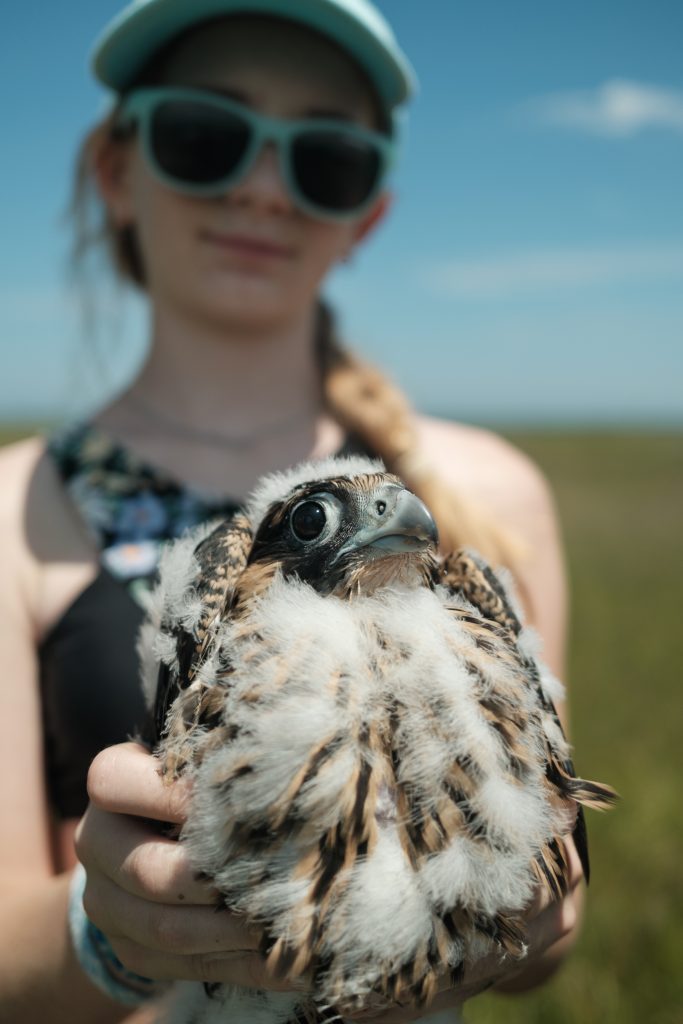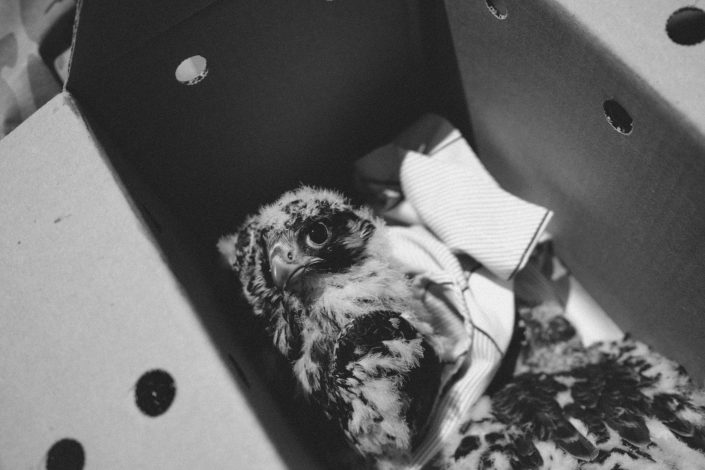New Jersey Peregrine Falcons: 50 Years of Recovery
by Ben Wurst / Senior Wildlife Biologist
It’s no surprise to hear that peregrine falcons have made a remarkable recovery since being extirpated from New Jersey in the mid-1960s. From the cliffs of the Palisades to bridges and buildings in our urban areas and along our entire coast, peregrines can be seen at many locations throughout the state. Today the population has been holding steady with 40 (known) pairs and at least 35 active nests over the last couple years. This is due to protection through the Endangered Species Conservation Act, where biologists worked tirelessly to jumpstart their recovery efforts by “hacking” young falcons and the banning of harmful pollutants, like DDT.
Each year known peregrine nests throughout the state are monitored for incubation and hatching of young. This is where biologists or trained volunteers visit a nest site to determine if eggs are present. If so, then the nest is monitored over several visits to determine total clutch size and an estimated hatch date. This is so we can determine the outcome and coordinate banding of young at an optimal age (3-4 weeks old). Banding is a crucial tool for migratory bird biologists to track movements of birds. With peregrines, we’re able to collect data on their life history through re-sightings or encounters of their bands. In the video below, you can learn more about how banding young peregrine falcons helps to determine their movements after they leave their natal areas, especially in the Palisades.
In 2023, forty two pairs were documented throughout the state, where thirty five pairs laid eggs (as compared to 43 pairs and 38 w/ eggs in 2022). A total of 29 nests were successful and produced a total of 71 young, which is an overall 83% success rate. Overall the productivity rate, which is a measure of the health of the population was 2.03 young/active (known-outcome) nest, which has been pretty consistent over the past several years.
The core of the population (16 active nests; 52% of young produced) continues to thrive along the coast, where peregrines nest atop buildings and towers. Nests on bridges and buildings along the Delaware River (6 active nests; 16 young fledged) and urban areas (7 active nests; 11 young fledged) had decent results. Lastly, natural nests within quarries and cliffs supported 9 active nests which produced only 7 young, which had the lowest productivity rate. Access to a few natural nests has been difficult which makes monitoring them impossible.



A total of 63 young were banded for future tracking with both a federal bird band and state auxiliary (bicolor/black over green) band. While monitoring nests, trail cams and cameras with telephoto lenses enabled the identification of 32 banded adults, which allowed us to determine their age, origin, site fidelity, and overall turnover within the breeding population. A total of thirteen unbanded adults were observed at nests and their origins are unknown. Overall, the oldest breeding peregrine was a female who was 15 years old. Overall, there were over 25 encounters or re-sightings of falcons who originated from New Jersey nests. One notable encounter was an alumni from the Jersey City Falcon Cam, who was one of the first that was named, “Alpine” or 40/S. He fledged from that eyrie in 2007 and was named after the cliffs that biologists hoped he would occupy in the future. Well, he actually wound up in New York City, which is thought to hold the largest population of urban nesting falcons in the world. He was injured and brought to the Raptor Trust for care and released in June 2023. He was found again in July but was eventually released and believed to return to his territory in NYC. We aren’t sure of his injuries but at that age, he was likely in a territorial dispute. In New Jersey we’re seeing higher turnovers of breeding adults as there are more peregrines looking to takeover existing nests and territories. Another notable encounter we had was with BE/96 or “Special Agent Dale Cooper” who was rescued from Barnegat Bay in March by a kayak fisherman. The short of the long (fascinating) story (linked below) is that Coop was attempting to take over the nest that he originated from and the male who killed his father! We would never of known this if he was not banded.
Overall, peregrine falcons continue to do well in New Jersey with nests on towers and buildings that have the highest success rate. Natural nests continue to have the lowest success rate but this has been the norm over the past ten years. This clearly illustrates how sites that are managed by humans and give them space to thrive can be a huge benefit to the species as a whole. A challenging aspect of this is having great partners who support peregrines who nest atop their privately owned buildings and infrastructure, like the Union County Courthouse in Elizabeth, which is home to the Union County Falcon Cam. Thanks to all the project volunteers, donors and partners who help ensure that peregrine falcons have a future in New Jersey!
>> Read the Peregrine Falcon Research and Management Program In New Jersey, 2023 Report
Discover more from Conserve Wildlife Foundation of NJ
Subscribe to get the latest posts sent to your email.

Leave a Comment
Nice report Ben. Thanks for all your hard work. It is great to learn that peregrines are doing so well in NJ and other areas in the eastern US. Jim
Thanks, Jim! I credit Kathy for the report. I simply summarized it in my post. 🙂
Interesting to see numbers over the years. Kudos to you, the staff, and the volunteers who all contributed to this bird’s recovery and continuance.
Yes, they have come a long way all thanks to improved environmental conditions and some hard working humans!
I am excited to read your blog, Ben! So grateful to
read the update about Alpine 40/S. NJ’s peregrines
are such treasures . Thank you for all the good you
you and your associates do for NJ wildlife. Keeping
my fingers crossed a pair will return to Jersey City.
Comments are closed.